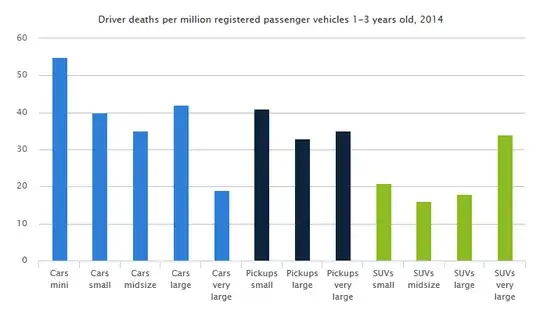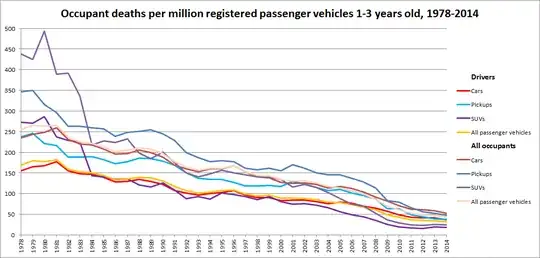In aggregate yes, however that's not the same as saying all large vehicles are safer than all small ones. The Insurance Institute for Highway Safety aggregates and publishes data about fatality rates in new vehicles in the US. You can see a general trend toward larger being safer, but bigger being safer is not guaranteed. The IIHS also publishes data about changes over time (available at the source); the short version though is that newer small cars compare favorably with older large ones.

Driver deaths per million registered passenger vehicles 1-3 years old, 2014
Registered vehicles Deaths Rate
Cars Mini 1,131,535 62 55
Small 7,251,650 288 40
Midsize 9,700,209 335 35
Large 2,741,490 116 42
Very large 1,724,015 32 19
All cars 22,548,899 838 37
Pickups Small 777,825 32 41
Large 3,495,386 115 33
Very large 1,167,182 41 35
All pickups 5,440,393 207 38
SUVs Small 3,662,803 76 21
Midsize 6,509,578 102 16
Large 1,734,489 31 18
Very large 377,309 13 34
All SUVs 12,284,179 223 18
All passenger vehicles All 40,887,585 1,290 32
For anyone interested in more details of how it breaks down per vehicle, I've found a report the IIHS did in 2011 showing stats for dozens of the most popular vehicles. This can be read online, but is an electronic copy of something that was apparently originally a bound paper booklet. The middle column of the per vehicle model table is split between two pages and is much easier to read if you have a large display and can download the pdf and view two pages side by side.
This is a noisy dataset (for many of the less common vehicles only a handful of fatal accidents are involved); but the spread within a single vehicle type is often larger than the spread between the averages for overall vehicle types. It's also several years old (2005-8 model years vs 2011-14 for the graph/table above).
Even in such a short period of time you can see the overall improvements in vehicle safety, the 55 deaths/million vehicle years rate for mini cars from 2011-14 is about a third less than the equivalent from 2005-08 models, and comparable to mid/large size cars from the era.
Over longer periods the overall improvement is even more dramatic. I made this graph from a table of data in the IIHS report linked to at the top of my answer. Modern vehicles of all types are roughly 5x less likely to kill occupants in accidents than they were 40 years ago. For SUV's its more like a 10x improvement; although that's mostly driven by massive improvements in the late 70s and early 80s that brought them inline with other vehicle types. Since then they've behaved more or less like any other vehicle type. You can also see the effect of electronic stability control becoming standard in pickup trucks at the end of the last decade as their survivability numbers improve significantly due to the reduction in rollover rates.


